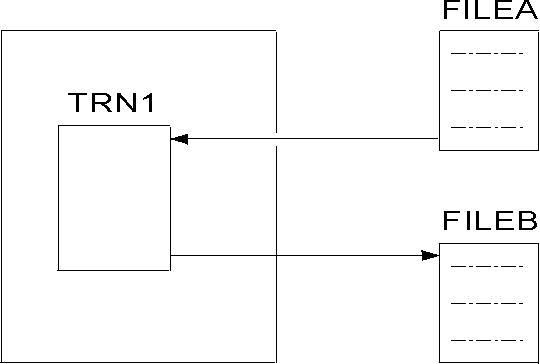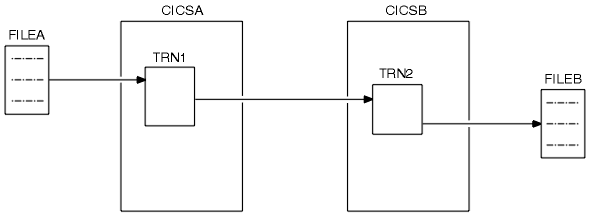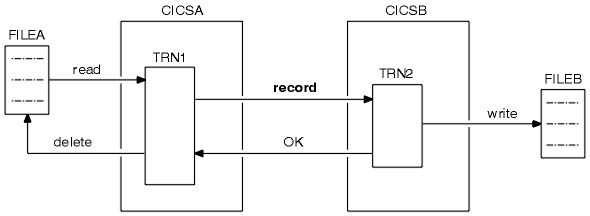When designing applications that update data on more than one system, it is important to remember that network or system failures sometimes occur. These failures are difficult to manage in a distributed environment because the application is exposed to partial failures that do not occur in a single-system environment. This is best shown with an example.
Consider the case of a single system in which an application is moving records between two recoverable files, FILEA and FILEB, as shown in Figure 1. If a problem occurs, for example, data is corrupted in one of the files, a transaction abends, or a CICS® region fails, CICS backs out the changes that were made before the problem occurred. Consequently, the files return to the state in which they were at the time the transaction was initially started.



Thus a record can never be lost because TRN1 deletes the record from FILEA only when it knows that the record is written to FILEB. However, if TRN1 fails after it receives the message to delete the record, but before the record is actually deleted from FILEA, thus the record appears twice, once in FILEA and again in FILEB.
In this application, it does not matter whether a customer's address is updated once or twice. However, if the data in FILEA represents money in some form, and the act of transferring it between the systems effectively transfers the money from one bank account to another, two copies of the record cause the money to be transferred twice.
A mechanism is required to ensure that the deletion from FILEA always occurs if the write operation to FILEB is successful and never occurs if the write operation to FILEB is unsuccessful. This requires a much more sophisticated coordination between the two systems.
- synchronization level 0 (NONE): SNA provides no synchronization support. The application must code its own.
- synchronization level 1 (CONFIRM): SNA provides the ability to send simple acknowledgment requests.
- synchronization level 2 (SYNCPOINT): SNA provides the ability for two or more CICS systems to treat the updates that are made by an application on these systems as one logical unit of work (LUW). (LUW is a synonym of unit of work (UOW)). When the application requests a synchronization point (sync point) by using the EXEC CICS SYNCPOINT command or the final EXEC CICS RETURN command, the updates on the remote systems are committed (made permanent) if, and only if, updates to recoverable data that are made locally by the transaction are also committed. If a failure occurs (for example, the transaction abends) before all involved systems have agreed to commit, all the updates for the application on each of the systems are backed out (undone). Alternatively, all updates are backed out if the application issues the EXEC CICS SYNCPOINT ROLLBACK command.
When SNA systems first establish contact, they agree the maximum synchronization that they will use. The synchronization level for each individual task is then determined either by CICS or by the application program. TXSeries for Multiplatforms supports all three synchronization levels across both SNA and TCP/IP. Refer to Designing your network configuration for more information about these communication methods.
If the remote system and the communication network are able, TXSeries for Multiplatforms uses synchronization level 2 conversations on function shipping, asynchronous processing, and distributed program link (DPL) requests. Transaction routing requests from TXSeries for Multiplatforms always use synchronization level 1 conversations because they do not update recoverable data on the local region. However, TXSeries for Multiplatforms can receive synchronization level 2 transaction routing requests from CICS Transaction Server for z/OS, CICS/ESA, CICS/MVS, and CICS/VSE. Distributed transaction processing (DTP) uses the synchronization level that is requested on the SYNCLEVEL parameter of the EXEC CICS CONNECT PROCESS command.
For further information on the CONNECT PROCESS command, see CONNECT PROCESS.
- CICS/MVS: 2.1.2
- CICS/ESA: 3.3 or higher
- CICS/VSE: 2.2 or higher
The following table summarizes the synchronization level that is used on outbound intersystem requests. Refer to the following legend:
- FS
- Function shipping
- TR
- Transaction routing
- AP
- Asynchronous processing
- DPL
- Distributed program link
- DTP
- Distributed transaction processing
- NS
- Not supported
| Function | FS | TR | AP | DPL | DTP |
|---|---|---|---|---|---|
| Synchronization level chosen by: | CICS | CICS | CICS | CICS | Application |
| Request to CICS/ESA, CICS/MVS, CICS/VSE, or CICS/400 using local SNA | 1 | 1 | 1 | 1 | 0 or 1 |
| Request to CICS/ESA, CICS/MVS, CICS/VSE or CICS/400 using a PPC Gateway and SNA | 2 | 1 | 2 | 21 | 0, 1, or 2 |
| Request to CICS OS/2 over SNA | 1 | 1 | 1 | 1 | 0 or 1 |
| Request to CICS OS/2, or TXSeries for Multiplatforms over CICS family TCP/IP | 1 | 1 | 1 | 1 | NS |
| Request to TXSeries for Multiplatforms using CICS PPC TCP/IP | 2 | 1 | 2 | 21 | 0, 1, or 2 |
| Request to TXSeries for Multiplatforms over SNA when both systems are using a PPC Gateway | 2 | 1 | 2 | 21 | 0, 1, or 2 |
| Request to TXSeries for Multiplatforms over SNA when one or both regions are using local SNA | 1 | 1 | 1 | 1 | 0 or 1 |
| Request to non-CICS system over SNA | NS | NS | NS | NS | 0, 1, or 2 |
| Request to TXSeries for Multiplatforms from CICS-TS or another TXSeries region over TCP/IP using IPIC support | NS | NS | NS | 1 | NS |
| Request to CICS-TS from TXSeries for Multiplatforms over TCP/IP using IPIC support | NS | NS | NS | 1 | NS |
| Note: 1.
DPL requests specifying SYNCONRETURN option use synchronization level
1 on all requests.
|
|||||